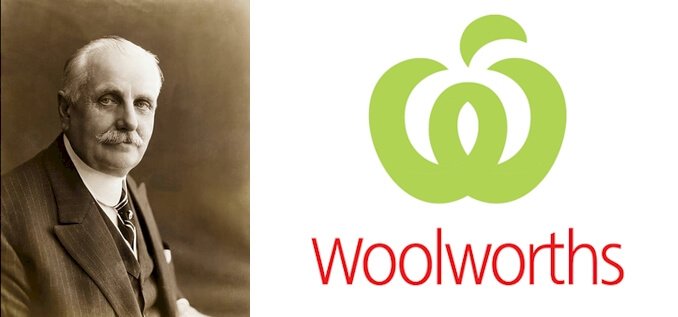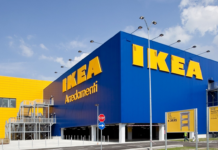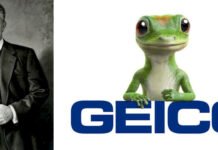Woolworths Group Limited has had several different logo designs since the first version was created in 1960.
The well-known “The Fresh Food People” symbol that made the brand recognizable for 20 years until 2007 made way for a new marquee design by Hans Hulsbosch—a green stylized “W” icon representing Woolworths. It somewhat harks back to a particular Woolworths logo version of the 1970s and aptly represents Woolworths’ slogan “the fresh food people.”
In early 2022, Woolworths Group unveiled a new logo design to “better portray its evolution as well as what its collective platforms and businesses represent.”
The new corporate identity replaced the company’s classic logo, which portrays its name alongside its five brands drawn in five different colors. At the same time, Woolworths supermarkets’ traditional business logo stayed the same.
Created in conjunction with M&C Saatchi Group’s Re, the new Woolworths Group logo features several wavy “W” letters and uses a blue color scheme. According to Andrew Hicks, Woolworths’ chief marketing officer, the multiple wavy “W” icons stand for “We,” portraying how the supermarket chain positively impacts its customers while depicting the “spirit of adaptability and agility.”
The Woolworths Logo Evolution
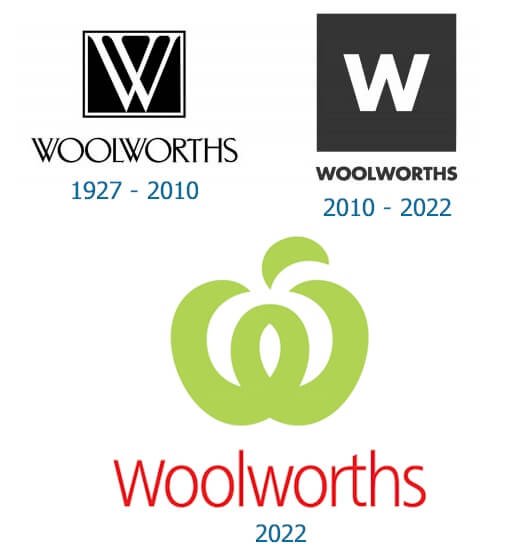
1960–1972
The design of this era consisted of a solid black uppercase “W” inside the upper part of a triangle, with five-star symbols scattered below it. The triangle was white on the inside and featured a thick black outline.
1972–1987
During this era, the Woolworths logo was a stylized red “W” icon, placed below a red “Woolworths” wordmark written in uppercase letters. The “W” icon appeared to depict two identical shopping bags placed side by side.
1987–2007
Woolworths introduced its slogan logo, “The Fresh Food People,” which it still uses today in some Australian locations like Eastwood and Booragoon.
The design consists of the italicized phrase “The Fresh Food People” in green, placed above the red “Woolworths” wordmark between three red-and-white bars.
2007–2012
The current stylized green “W” icon representing Woolworths was introduced in 2007. The icon resembles two green apples overlapping each other to look like “W.” Below the icon was the “Woolworths” wordmark in red placed above “the fresh food people” slogan.
2012–2014
The previous Woolworths logo design was retained during this brief period, but red was removed from the color scheme. The company changed its slogan from “the fresh food people” to “Australia’s fresh food people” to reflect its promise to deliver fresh Australian produce to its customers.
2014–2015
Woolworths’ original slogan, “the fresh food people,” was brought back during this period. The green stylized “W” icon was retained, as was the “Woolworths” wordmark.
2015–Today
The present green stylized “W” icon representing Woolworths first appeared in 2007 and has had a few minor changes to the wordmark and slogan since then. In late September 2015, a new handwritten variant of Woolworths’ slogan began appearing in catalogs.
The Woolworths Logo Design Elements

Color: The current Woolworths “W” symbol is drawn in various shades of green, which add depth and volume to it and makes it look like a pair of fresh apples overlapping each other.
Font: The current “Woolworths” wordmark is written in title case using a green shade. While the company’s slogan is also written with a green shade in lowercase letters, it appears handwritten.
The History of Woolworths

Woolworths (affectionately called “Woolies” in Australia) is an Australian grocery store and supermarket chain owned by the Woolworths Group. As of 2019, Woolworths was the largest supermarket chain in Australia, with a 33 percent market share.
Woolworths sells groceries (vegetables, meat, fruit, packaged foods, etc.) and magazines, health and beauty supplies, DVDs, stationery, baby and pet supplies, and household products. There were 64 Woolworths Metro groceries stores and 987 Woolworths supermarkets by June 30th, 2020.
Woolworths Online (formerly called HomeShop) is Woolworths supermarkets’ home delivery and “click-and-collect” service.
Early History
Woolworths Group (formerly Woolworths Limited) was founded in September 1924 in Australia by five Aussie entrepreneurs Ernest Williams, Percy Christmas, Stanley Chatterton, Cecil Scott Waine, and George Creed.
The quintet opened their first store in December 1924 at Imperial Arcade, Sydney, named “Woolworths Stupendous Bargain Basement .” After the first store was opened, the supermarket had just 29 shareholders, and no one seemed interested in speeding up the brand’s growth. But as shareholders pumped in more capital and operations continued, the company’s dividends rose from 5 percent to 50 percent by the third anniversary of its operation.
After December 1924, more and more customers became interested in Woolworths stores as they opened more of its branches all over Australia. Woolworth stores started selling a range of products, offering the lowest prices in addition to money-back guarantees. Leading the way in innovation, Woolworths was the world’s first variety store to set up printing cash register systems in 1926.
In August 1927, Woolworths opened its second supermarket on Queen Street, Brisbane. Woolworths opened its first New Zealand store two years later, but the chain is now known as Countdown. By 1940, Woolworths had opened stores in all Australian states.
With Woolworths and its branches running successfully, the company started experimenting with widening its grocery collection—more stores started stocking fresh vegetables and fruits and a large variety of food.
In 1955, Woolworths opened its first self-service location in Sidney’s Beverly Hills. In 1958, the company opened its first supermarket at Dee Why, following that up in 1960 with its first purpose-made supermarket at Warrawong. As Woolworths gradually specialized in groceries, it opened its first department store at Tamworth in New South Wales in 1976.
In 2018, Woolworths and Coles Supermarkets stopped giving out single-use plastic bags at checkout, following the lead of the third-largest supermarket chain in Australia, Aldi. Australia’s plastic bag use dropped by 80 percent in the next three months, resulting in 1.5 million fewer plastic bags ending up in landfills. That same year, Woolworths also committed itself to get rid of 180 tons of plastic wrapping from their products.
Slogans
Woolworths launched its slogan “The Fresh Food People” in 1987, after operationalizing new company practices for its fresh food departments.
In 2012, the slogan was altered slightly to “Australia’s Fresh Food People,” reflecting the fact that Woolworths supermarkets sold 96 percent of fresh produce grown in Australia. In 2014, the company brought back its first slogan, “The Fresh Food People,” with a new series of TV commercials.
Acquisitions
In 1958, Woolworths Ltd bought all 32 Cash & Carry stores in Brisbane. The popular Brisbane grocery stores were later rebranded to Woolworths stores.
Woolworths Ltd bought a pair of Tasmanian grocery brands in 1982—Purity and Roelf Vos, which it converted into Woolworths stores 18 years later.
After giant US supermarket chain Safeway Inc. entered the country in 1962, Woolworths acquired Australian Safeway Proprietary Limited in 1985. In return for a 19.99 percent shareholding in Woolworths Limited, the company bought all Safeway stores in addition to the naming rights. Safeway had 126 locations across New South Wales, Queensland, and Victoria.
All New South Wales and Queensland Safeway stores were rebranded to Woolworths, but most Victorian locations continued operating as Safeway. Woolworths announced it’d rebrand Safeway locations to Woolworths and completed this process in June 2017.
Loyalty Schemes
Woolworths’ loyalty schemes comprise various incentives for shopping at their grocery stores and supermarkets by subsidizing fuel prices at the company’s Caltex petrol stations and the now non-operational Woolworths Plus Petrol. The discounts included 2 to 10 cents off on petrol, rewarded for buys beyond specific amounts.
Credit Card and Everyday Rewards
Woolworths started trialing the Everyday Rewards program in west-central New South Wales in September 2007. Everyday Rewards is a card that automatically tracks Woolworths supermarket buys and fuel discounts, therefore ruling out the need for customers to hold on to their paper coupons. Moreover, it lets Woolworths record purchases to offer customers suitable promotions and use it for research on marketing and demographics.
This followed the company’s announcement that it’d introduce a general use credit card a year later. General use credit cardholders were offered reward vouchers which they could redeem at any Woolworths supermarket or grocery store. Shortly afterwards, Woolworths announced that it’d launch its Everyday Money MasterCard in August 2008, letting customers earn shopping cards they would redeem at any Woolworths store.
Following the trial in New South Wales, Woolworths announced that it’d roll out its Everyday Rewards program countrywide. In mid-February 2008, implementation started with the North Territory and South Australia, followed by other states (bar Tasmania) by the 31st of May 2008. The New South Wales pilot saw 50,000 cards issued to customers.
In June 2008, Woolworths said that more than 1 million customers had been issued with a card and registered it. Two months later, 3.8 million Everyday Rewards cards were made available to shoppers, with 2.4 million of them registered.
Starting June 2009, holders of Everyday Rewards cards were eligible for Qantas Frequent Flyer tokens through their cards. Those who had managed to link their Everyday Rewards card with their Qantas Frequent Flyer card would be able to earn 1 Frequent Flyer point per every dollar spent above $30 at any Woolworths store.
In August 2016, Woolworths significantly altered its Everyday Rewards scheme in response to consumer feedback. Everyday Rewards cardholders would be able to earn a point for every $1 spent on relevant products at Caltex Woolworths fuel stations and Woolworths supermarkets. Once a customer accrues 2000 points, they can get a $10 discount on their next transaction at any Woolworths supermarket.
Shoppers were also offered the option to keep their discounts accumulating until the festive season, enabling them to use their discounts from the 1st of December to the 1st of January every year. Woolworths also brought back the option of customers being able to earn Frequent Flyer points by using their Everyday Rewards card. Once a customer accrues 2,000 Everyday Rewards points, they can exchange them for 1,000 Frequent Flyer tokens.
Frequent Shopper Club
Stylized as F$C, Woolworths’ Frequent Shopper Club was a loyalty reward scheme for shopping at Woolworths stores and supermarkets in Tasmania. Purity Supermarkets started the program in 1992, and it ran until January 2021.
Once a customer earned 2,000 Frequent Shopper Club points, they’d earn a $20 voucher. Woolworths designed a simple website for the reward program in November 2017. In July 2020, the supermarket chain announced that the Everyday Rewards program would absorb the Frequent Shopper Club.
Woolworths’ Assets
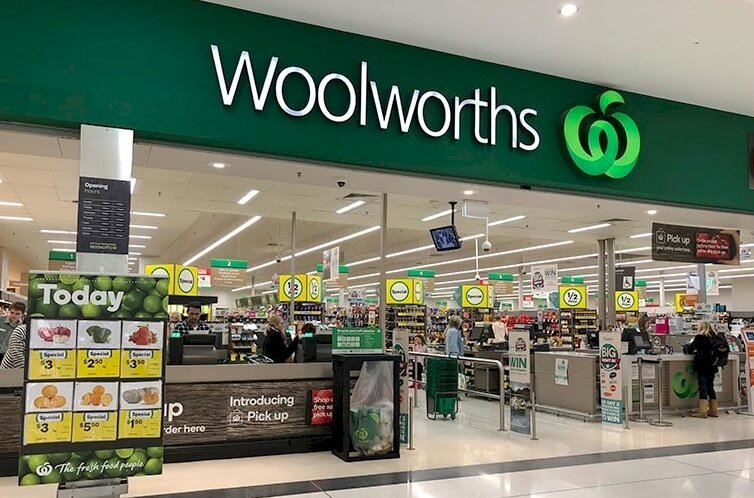
Today, Woolworths Group is made up of three company divisions: Portfolio, Australian Food, and New Zealand Food.
Portfolio
- Big W is Woolworths’ budget department store network, which sells a wide variety of general merchandise, including hardware, books, stationery, household products, toys, sporting goods, recorded media, clothing, software, pet food, health, and beauty supplies, and automotive products.
Australian Food
- Australia’s biggest supermarket chain Woolworths operates 995 stores all over Australia.
- Woolworths’ customer loyalty scheme Everyday Rewards offers rewards, discounts, and fuel savings.
- Woolworths Financial Services and Insurance provides a variety of Woolworths’ financial products across gift cards, credit cards, and insurance.
New Zealand Food
- New Zealand’s flagship supermarket chain Countdown consists of 184 full-service budget supermarkets operating all over the country’s South and North islands.
- FreshChoice is a franchised full-service supermarket in New Zealand.
- SuperValue is a franchised convenience supermarket in New Zealand.
Summing Up the History of Woolworths
Woolworths Group Ltd is an Australian-owned public company, earning revenue from selling fresh Australian produce and general merchandise. Approximately 210,000 people work for Woolworths, headquartered in Sidney and operates all over Australia and New Zealand.
Founded as Woolworths Limited, a variety retailer, in Sydney in 1924, the supermarket and grocery chain store expanded into New Zealand in 1929 and has operated in all Australian territories and states since 1960.
Woolworths has gone through significant consolidation since 2012, divesting its hospitality, liquor retailing, fuel retailing, home improvement, electronics retailing, and shopping center businesses to focus on its supermarket businesses.
Today, Woolworths owns Woolworths Supermarkets, Big W discount department stores, and Everyday Rewards customer loyalty scheme in Australia. In New Zealand, the company owns the Countdown, FreshChoice, and SuperValue supermarkets.

